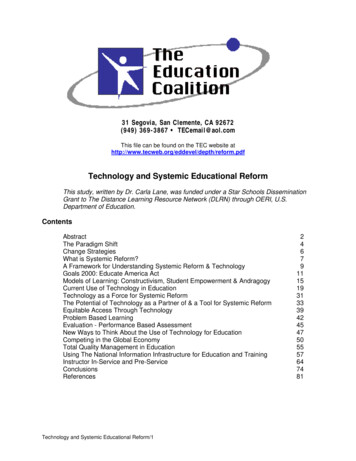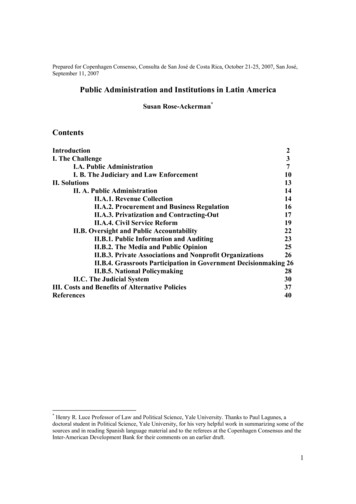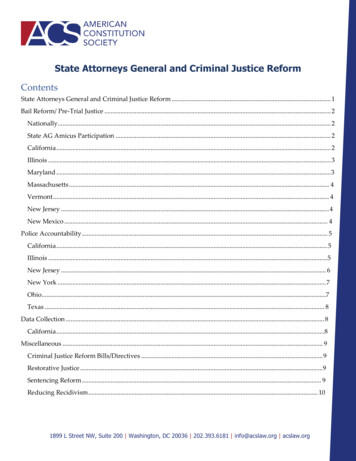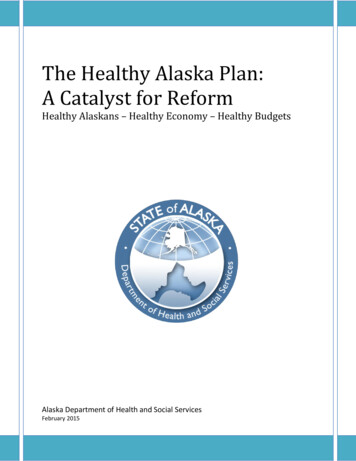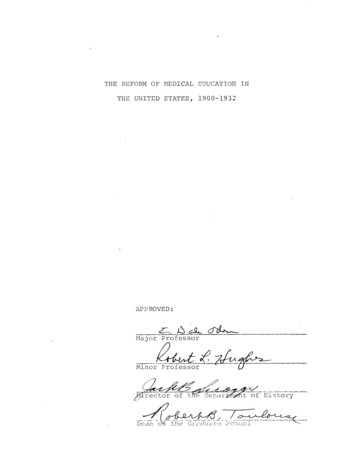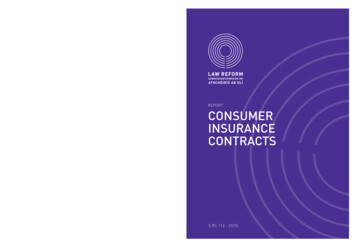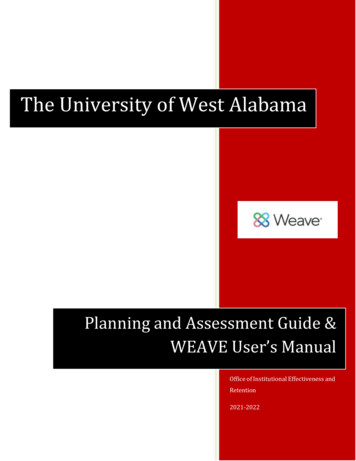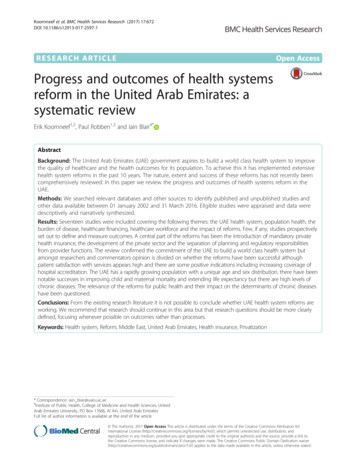
Transcription
Council on Graduate Medical EducationSubcommittee on Medical Education Programs and FinancingReform in Medical EducationandMedical Education in the Ambulatory SettingU.S. DEPARTMENT OF HEALTH AND HUMAN SERVICESPublic Health ServiceHealth Resources and Services Administration
HEALTH RESOURCESAND SERVICES ADMINISTRATION"HRSA -Helping Build A Healthier Nation"The Health Resources and Services Administrationhas leadership responsibility in the U.S. Public HealthService for health service and resource issues. HRSApursues its objectives by: Supporting states and communities in deliveringhealth care to underserved residents, mothersand children and other groups;Participating in the campaign against AIDS;Serving as a focal point for federal organ transplant activities;Providing leadership in improving health professions training;Tracking the supply of health professionals andmonitoring their competence through operationof a nationwide data bank on malpractice claimsand sanctions; andMonitoring developments affecting health facilities, especially those in rural areas.
Council on Graduate Medical EducationSubcommittee on Medical Education Programs and FinancingReform in Medical EducationandMedical Education in the Ambulatory SettingScholar in Residence ReportPrepared by:Dona L. Harris, Ph.D.Scholar in ResidenceU.S. DEPARTMENT OF HEALTH AND HUMAN SERVICESPublic Health ServiceHealth Resources and Services AdministrationBureau of Health ProfessionsDivision of MedicinePub.No. HRSA-P-DM-91-4
ACKNOWLEDGMENTThe preparation of this Scholar in Residence Report of theCouncil on Graduate Medical Education (COGME) was assisted greatly by staff of the Council and others. Debbie M.Jackson, M.A., staff liaison for the COGME Medical Education Programs and Financing Subcommittee and Carol S.Gleich, Ph.D., Executive Secretary of COGME were helpfulin finalizing the report. Eva Stone, Committee ManagementAssistant, provided able administrative support.A special acknowledgment and thanks to Ceal Neally, RPh,who designed the cover, graphics and the layout of thisreport.I extend my sincere thanks to the Council, the Subcommittee,and all who contributed to the report.Dona L. Harris, Ph.D.Scholar in Residence
TABLE OF CONTENTSiiiPURPOSEviiPREFACEixLIST OF MEMBERSXlLIST OF SPEAKERSxiiiREFORM IN MEDICAL EDUCATION1SPEAKERS: REFORM IN MEDICAL EDUCATIONINTRODUCTION: REFORM IN MEDICAL EDUCATIONDona L. Harris, Ph.D.3THE EDUCATION OF MEDICAL STUDENTS FOR TOMORROWDavid E. Rogers, M.D,5WHY MEDICAL EDUCATION HAS NOT CHANGEDChristine McGuire, Professor Emerita9STUDY OF MEDICAL SCHOOLS AND MEDICAL EDUCATIONLeighton E. Cluff, M . D . - - - - - - - - - - - - - - - -19"AAMC/CULPEPER STUDY: ASSESSING CHANGE IN MEDICALEDUCATION--THE ROAD TO IMPLEMENTATION (ACME-TRI)"Louis J. Kettel, M.D25MEDICAL STUDENTS' SPECIALTY CHOICESAugust G. Swanson, M.D.35THE ROLE OF ADMISSIONS POLICIES IN MEDICAL EDUCATIONHoward K Rabinowitz, M . D . - - - - - - - - - - - - - -41THE BASIC SCIENCE YEARSParker A Small, Jr., M.D.45AMBULATORY SETTINGS FOR CLINICAL EDUCATIONLarry Culpepper, M . D . - - - - - - - - - - - - - - - -49RESPONDENTChristine McGuire, Professor E m e r i t a - - - - - - - - - - -61RESPONDENTDaniel M. Fox, Ph.D.65Page v
TABLE OF CONTENTS (con't)MEDICAL EDUCATION IN THE AMBULATORY SETTING71SPEAKERS: MEDICAL EDUCATION IN THE AMBULATORY SETTINGINTRODUCTION: MEDICAL EDUCATION IN THE AMBULATORY SETTINGDona L. Harris, Ph.D.73QUALITY PREDOCTORAL TRAINING IN THE AMBULATORYSETTINGW. Douglas Skelton, M.D.75THE CLINICAL TEACHER--A FORGOTTEN LINK IN MEDICALEDUCATIONKelley Skeff, M.D., Ph.D.79PEDIATRICS IN THE AMBULATORY SETTINGO.J. Sahler, M.D.83GENERAL INTERNAL MEDICINE IN THE AMBULATORY SETTINGSteven A. Wartman, M.D., Ph.D.89FAMILY PRACTICE IN THE AMBULATORY SETTINGMichael Gordon, P h . D . - - - - - - - - - - - - - - - - 95Howard K. Rabinowitz, M . D . - - - - - - - - - - - - - - 101RESPONDENTThomas L. Delbanco, M . D . - - - - - - - - - - - - - - - 105RESOURCESPage vi113
Public Health ServiceHealth Resources andServices AdministrationRockville MD 20857PURPOSEThis monograph is the product of formal presentations made at two meetings ofthe Council on Graduate Medical Education's Subcommittee on Medical EducationPrograms and Financing. It is also the final project of Dona L. Harris, Ph.D.,Scholar in Residence to the Council from September 1, 1989 to September 1,1991.The first meeting of the Subcommittee was held on June 18-19, 1990 andaddressed REFORM IN MEDICAL EDUCATION. The second meeting wasSeptember 26, 1990 and focused on MEDICAL EDUCATION IN THEAMBULATORY SETTING. The contents are provided because of timely nationalimportance and interest. The presentations do not, however, reflect official policypositions of the Council on Graduate Medical Education.Respectfully submitted,Nuieee.J Neal A. Vanselow, M.D.ChairmanCouncil on Graduate Medical EducationSeptember, 1991Page vii
PREFACEThe Subcommittee on Medical Education Programs and Financing of the Council onGraduate Medical Education has had the exciting and enlightening privilege ofparticipating in a number of discussions with outstanding experts and leaders inAmerican medical education. In particular, the Subcommittee listened to a numberof formal presentations in June and September of 1990.Because the topics discussed were not only of broad interest but of significantimportance to medical education in the United States, formal presentations byinvited experts were made to the Subcommittee. We have felt that there would bea high degree of interest in these materials and are pleased to have the privilege ofmaking them available to you.The Subcommittee wishes to express its formal and deep appreciation to thepresenters whose individual and aggregate contributions have made this monographpossible. It should be pointed out that the views that they express are their ownand have not been endorsed as positions of either the Subcommittee or the Councilon Graduate Medical Education (COGME). Nevertheless, the Subcommittee didfind them to be extremely valuable, thought-provoking, and worthy of our furtherconsideration as well as your own. It is in that spirit of continued consideration andcollaboration that we advance them to you.The Subcommittee has also benefited from the rewarding experience of having theCouncil's Scholar in Residence, Dona L. Harris, Ph.D., work with us. In addition toorganizing the logistical details of the meetings and presentations, she has alsobeen the primary editor and facilitator in bringing this project to conclusion. It iswith a high level of appreciation that I express the gratitude and thanks of theSubcommittee members for the effective efforts and valuable contributions of Dr.Harris. We wish her well in her new responsibilities as she leaves COGME.Respectfully submitted, -S 0.CecilSamuelson, M.D.ChairmanMedical Education Programs andFinancing SubcommitteePage ix
COUNCIL ON GRADUATE MEDICAL EDUCATIONSUBCOMMITTEE ON MEDICAL EDUCATION PROGRAMS AND FINANCINGCbajrnersonCecil 0. Samuelson, Jr., M.D.Senior Vice President for Medical AffairsIntermountain Health Care, Inc.36 South State Street, 22nd FloorSalt Lake City, Utah 84111MembersDipali V. ApteMedical Scholars ProgramUniv. of Illinois College of Medicine190 Medical Sciences Building506 South MatthewsUrbana, IL 61801Robert G. Eaton(HCFA Designee)Assoc. Admin. for Program Dev.Health Care Financing Admin.Room 325H, HRH Building200 Independence Avenue, S.W.Washington, DC 20201Lawrence U. Haspel, D.0.Executive Vice PresidentHospital OperationsChicago College of Osteopathic Medicine5200 South Ellis AvenueChicago, IL 60615Stuart J. MarylanderVice Chairman of the BoardNU-Med, Inc.16633 Ventura BoulevardEncino, CA 91436James A. Pittman, Jr., M.D.DeanUniv. of Alabama, BirminghamSchool of MedicineUniversity StationBirmingham, AL 35294Peter F. Regan, M.D.(VA Designee)Assistant Chief Medical Directorfor Academic AffairsDepartment of Veterans Affairs810 Vermont Ave., N.W., Room 874Washington, DC 20420Margaret T. Stanley, M.H.A.AdministratorWashington State Health CareAuthority4505 Woodview Drive, SE, QF 31Olympia, WA 98504Charles E. WindsorPresident & Chief Executive OfficerSt. Mary's Hospital129 North 8th StreetEast St. Louis, IL 62201Staff J.jajsonScholar ip ResidenceF. Lawrence Clare, M.D., M.P.H.Chief, Data Analysis SectionSpecial Projects and Data Analysis BranchDivision of MedicineBureau of Health ProfessionsRoom 4C-25, Parklawn Building5600 Fishers LaneRockville, MD 20857(301) 443-6326Dona L. Harris, Ph.D.Council on Graduate Medical EducationDivision of MedicineBureau of Health ProfessionsRoom 4C-25, Parklawn Building5600 Fishers LaneRockville, MD 20857(301) 443-6785Page xi
LIST OF COGME SPEAKERSLeighton E. Cluff, M.D.Robert Wood Johnson FoundationP.O. Box 2316Princeton, NJ 08543-2316Larry Culpepper, M.D.Associate Professor, Family MedicineBrown University Memorial HospitalFamily Care Center89 Pond StreetPawtucket, RI 02860 Thomas L. Delbanco, M.D.DirectorDivision of General Medicine and Primary Care Beth Israel Hospital330 Brookline AvenueBoston, MA 02215Daniel M. Fox, Ph.D., PresidentMilbank Memorial Fund1 East 75th StreetNew York, NY 10021 Michael J. Gordon, Ph.D.Department of Family Medicine RF-30University of WashingtonSeattle, WA 98195Dona L. Harris, Ph.D.Kalamazoo Center for Medical Studies 1535 Gull Road, Suite 230Kalamazoo, MI 49001Louis J. Kettel, M.D. Vice President for EducationMichigan State UniversityVice President for Academic AffairsAssociation of American Medical CollegesChristine McGuireProfessor EmeritaDepartment of Medical EducationUniv. of Illinois College of Medicine2231 East 67th StreetChicago, IL 606491 Dupont Circle, N.W., Suite 200Washington, DC 20036 Howard K. Rabinowitz, M.D.Jefferson Medical CollegeDepartment of Family Medicine1015 Walnut StreetPhiladelphia, PA 19107 David E. Rogers M.D.Walsh McDermott UniversityProfessor of Medicine O.J. Sahler, M.D.Associate Professor, Pediatrics, Psychiatry, MedicalHumanities & Medical InformaticsUniversity of Rochester, Box 690Strong Memorial HospitalRochester, NY 14642Cornell University Medical College1300 York Avenue, Room A127New York, NY 90021 Kelley Skeff, M.D., Ph.D.Department of Medicine (S102)Stanford University School of Medicine300 Pasteur DriveStanford, CA 94305 W. Douglas Skelton, M.D.DeanSchool of Medicine Mercer UniversityParker A. Small, Jr., M.D.Professor of Immunology and Medical Microbiology1400 Coleman AvenueMacon, GA 31207Professor of PediatricsUniversity of FloridaCollege of Medicine3454 Northwest 12th AvenueGainesville, FL 32605 August G. Swanson, M.D.Vice President for Graduate MedicalEducation & International ProgramsAssociation of American Medical Colleges1 Dupont Circle, N.W., Suite 200Washington, DC 20036 Steven A. Wartman, M.D., Ph.D.Director, Division of General Internal MedicineRhode Island HospitalProfessor, Medical & CommunityHealthBrown University593 Eddy StreetProvidence, RI 02903Page xiii
REFORM INMEDICAL EDUCATIONJune 18-19, 1990Page 1
Reform in Medical Education and Medical Education in the Ambulatory SettingPage2
Introduction - Reform in Medical EducationDona L. Harris, Ph.D.Scholar in Residence5.The medical knowledge and technologyexplosion.INTRODUCTION6.The severe disparities that exist in payand reimbursement among medical specialists. In a recent JAMA article, therange of pay was reported to be 87,000 forfamily physicians to 193,000 for theorthopaedic surgeon.7.The discussion, movement, and controversy over training in the ambulatorysetting.8.Training focusing on preparing physiciansto be businesspersons. litigators. and bureaucrats to the detriment of training physicians to be care-givers. friends. and counselors.9.The subordination ofteaching among medical faculty with primary emphasis on research and clinical income generation, responding to economic incentives. even survival, first.10.Few institutions have defined their endproducts. Many students have no ideawhat receiving the M.D. means and whatskills and responsibilities accompany itspossession; nor have institutions made acommitment to serve people within theircommunity.REFORM IN MEDICAL EDUCATIONIt is a pleasure to welcome members of thesubcommittee, guest speakers, and colleaguesto our first meeting on medical education. Asyou may know, the Council on Graduate MedicalEducation currently consists of three subcommittees: 1) Medical Education Programs andFinancing; 2) Physician Manpower; and 3)Underrepresentation of Minorities in Medicine.One area that inextricably links all three subcommittees is the character and size of themedical professional pipeline. Our current equity and access problems will continue to drainus, or perhaps keep our committee-work going,if we do not address the pipeline issue. Althoughwe need to look beyond the medical educationyears, we need to address them first.Some of the major issues facing medical education today include the following:1.2.3.4.The declining interest in medicine as acareer. This erosion is especially criticalwith few underrepresented minority physicians currently in practice and very fewin the medical education training process.Yes, the list is long. And the list is not new. In1909 EliH. Long, PresidentoftheAAMC, pointedThe skyrocketing debts of our graduating out in his president's address that "the greatestmedical students. This is also especially deficiency in the conduct of the medical courselinked to the future enrollment of today is the failure to train the student to thinkunderrepresented minorities.and reason out matters for himself. Medicaleducation," he explained, "should make ourThe continuing pockets of physician short- graduates thinking and reasoning men ratherage especially in many rural and urban than encyclopedic men."communities.Since 1909 there has been much written aboutThesteadilydecreasingnumbersofgradu- medical education reform. Many think the probating medical students pursuing primary lems with medical education are a result of thecare careers.curriculum; others think they reflect a problemin the profession of medicine.Page3
Reform in Medical Education and Medical Education in the Ambulatory SettingIn reviewing the most recent Journal of the your interaction. The agenda provides for opAmerican Medical Association's issue on medi- portunities for discussion, and I hope none of uscal education, it was noted that some of the 126 misses those opportunities.medical schools have made curricular changes.In the basic science years, 6 schools have theproblem-based track format for the entire class;2 as its major instruction. Only 69 of the 126have required family practice clerkships. Mostinstitutions teach with a traditional format oftwo basic science years and two clinical years,with varying degrees of residency "frequent flying" in the fourth year of medical education.Many foundations have expressed concern aboutmedical education and have invested dollars intrying to address the most significant issues.The Josiah Macy Foundation supported thepreparation and subsequent publication ofCLINICAL EDUCATION AND THE DOCTOROF TOMORROW. In addition many experiments and meetings are currently supported byother foundations including the Robert WoodJohnson, Carnegie, Milbank, Kellogg, Culpeper,and the Pew Charitable Trust.With so much written on the NEEDforreform inmedical education, it is time to place some actionbehind our words. I couldn't help but think ofmedical education while I was at Harper's Ferry,West Virginia, yesterday. I am sure many ofyouare familiar with the role John Brown, theabolitionist, played in beginning the Civil War.He became militant and also lost his life pursuing what he strongly believed in. He thought ourcountry was the "discussion" nation, and wordsweren't solving the slavery issue.Well, I don't think we should become militant, orlose our lives. But without appropriate changesin medical education, some future lives will beon the line. We do need some action, and that iswhat I hope we can begin doing today: what canand should we be doing to assure improvementin the medical education process.We are very fortunate to have assembled somany interested individuals who are experts inmedical education. I would like to encouragePage4
The Education of Medical Students for TomorrowDavid E. Rogers, M.D.Walsh McDermott UniversityProfessor of MedicineCornell University Medical Collegemuch of a more sophisticated public likesdoctors much less than in days past. Thepublic characterizes us as too cold, too selfish, too busy, too impatient with them, toouncaring and making too much money.THE EDUCATION OF MEDICALSTUDENTS FOR TOMORROWIt is my hope that this will be a no-holds barreddiscussion--not a series oflectures.So, first, let me set the stage by giving you someofmy views on where we are faltering in medicaleducation today. Second, let me try out somegeneral objectives that I consider as goals of theprocess. And third, let me share with you someof the recommendations which came out of aMacy Conference I chaired two years ago andsee: (a) if they still make sense today; (b) if youfeel they make enough sense to try to implementsome or all of them.There is, to my sorrow, considerable and increasing evidence that medical education is introuble nowadays. Consider the following: The number of well-educated college students selecting medicine as a career is falling sharply.The fact that medicine is simply not viewed asbeing as attractive a life role as previouslyprobably stems from multiple changes in ourworld. Those changes include an increasinglyregulatory climate surrounding medicine; thedisappearance of the solo entrepreneurial practice and its replacement with massive, bureaucratic, high-technology institutions; and a disturbingly litigious patient population. All ofthese are part of it.But I am afraid there is also considerable evidence to suggest that medical school experiencesper se contribute to this loss of appeal, and thatmuch of what we do in our teaching programs isoutdated, too expensive, too pedantic and out ofsync--socially, factually, and pedagogically withthe needs of our times.All of this comes as no surprise to any of you.Medical faculty have been scolded, lectured, andwhite-papered to death about their pedagogicalsins and misdeeds. Multiple distinguished commissions, task forces, and committees have toldus to mend our ways. But despite all the rhetoric, startlingly little change has occurred.Why has this been so? I believe that the reasons Too many medical students today are find- for this recalcitrance are obvious, but both weing their medical school experience an un- and our critics have been surprisingly quietpleasant trial rather than a treat.about them. They are three-and all compellingand fundamental. First, there have been pre Too many residents-feeling insecure, un- cious few faculty-oriented incentives to encoursupported, and under-rewarded in general- age change in our educational program. Indeed,ist medical careers-are turning to super- most of the incentives have been perverse.specialized fields. In so doing they are often There are significant hazards to life, limb, andputting a technology-intensive wall between career advancement awaiting faculty who wishthemselves and their patients, and alas, to spend significant time on teaching or imthey have plenty of faculty role models to provement of curriculum. The worldly rewardsencourage them to do just that.for such endeavors are few, if not nonexistent.All faculty know this very well, and this reality And last, and perhaps this should be of has been am ply documented. Being an educatorgreatest concern to medical educators, too is not what gets a faculty member browniePage5
Reform in Medical Education and Medical Education in the Ambulatory Settingpoints in medical academe.The second reason for lack of change, though wehate to surface this one, is the fact that themedical school establishment has become thechild-if not the ward-of the public sector.First by becoming dependent on federal largessfor our research ventures, then by acceptingfederal monetary rewards for taking in morestudents, and finally by using federal and statemonies to pay our clinical faculty very generously (with funds from programs legislated tosupport care for the elderly, the poor, womenand children without means, and the disabled),we gave away much of our capacity to act independently. The fact that the major payer of thebills wanted an increasing say about the tune tobe played should not surprise us. To changemedical education now requires changing notonly ourselves but also federal and state attitudes and funding streams.how exalted, unless it is clear to them that thechange will improve the life and lot of thatfaculty. Unless this is crystal clear, any recommendations no matter how inspired, will go theway of those preceding them. Faculty do notneed more berating; they need encouragement,rewards, and fun in their teaching lives.So what might be our general educational obj ectives? In talking with Cornell faculty recently Ilisted seven. Let me try them out on you.First, it is to help students learn the language ofmedicine and something of the disciplines thatare its underpinnings. Despite the apparentsimplicity of this statement, this is no smalltask. The languages of anatomy, of biochemistry, of physiology, of pathology, of molecularbiology, are demanding and complex.Second, it is to introduce young men and womento the ways of science. We want them to gainfamiliarity with the tools that can and are beingAnd last and most mortifying, by our failure to used to explore problems in modern biology and,guard our precious responsibilities for the edu- most important, to understand and respect thecational independence of institutions giving the nature of scientific evidence with all that thisMD degree, we gave away much of the store and implies.sharply restricted our opportunities to try innovative or risky experiments in admission and Third, we hope to help students learn ways ofeducation. We did so by giving external bodies- reasoning logically, deductively, and accurately.examining groups and specialty boards--the fi- They must learn to work swiftly from availablenal say in what the doctor should be. Thus today evidence toward both the formulation of a probwe have medical institutions comparing them- lem and its solution. This is a difficult task inselves orjockeyingforposition on the basis of the medicine. Physicians must acquire both theMedical College Admission Test averages of ability and the reasonable comfort required tothose they admit. Incredible! Further, to pre- deal with ambiguities, uncertainties, and gapstend that National Board scores-or even the in knowledge when the stakes are often verypercentage of a school's students passing Na- high. Despite those uncertainties, they musttional Board examinations-represents some formulate and make decisions-often decisionskind of Good Housekeeping Seal of Approval with profound human implications.demonstrating a school's educational excellenceseems to me a declaration of educational bank- Fourth, we wish to help students become goodruptcy! This situation could be swiftly changed communicators. We want them to learn ways ofif we decided we wished to; but faculty are interacting with other human beings of widelystartlingly lethargic when it comes to curricular varying backgrounds, cultures, and value sysreform.tems, so that they can better understand anddeal with the problems of illness and humanLet me cite a verity: No faculty will listen to misery that are brought to them.what authorities espouse for change, no matterPage6
The Education of Medical Students for TomorrowFifth, and it builds on the above, we hope toexpand the individual student's capacities forconstructive empathy, helping others by the useof his or her own compassion. Doctors needsensitive antennae to know how those who arepatients feel about their problems, and, in sodoing, help them strengthen their own copingskills.should introduce a better blend ofhumanismand science into our health care institutionsand the students they graduate. Modern physicians should pay more attention to health promotion, disease prevention, and the social, environmental, andemotional factors bearing on health. Both the physicians who graduate and theSixth, though there is less general agreement onthis point, some of us feel we should strive toacademic medical institutions that produceturn out physicians whose social concerns exthem should have a strong sense of socialresponsibility for the health and medicaltend well beyond just the delivery of care tothose who seek it. It is my view that doctors'care rendered in their communities. It is ofparticular concern that inadequate fundingconcerns should also encompass the needs ofthose who do not find their way to servicesof health care for the poor most severelybecause of ignorance, or poverty, or isolation. Iaffects those medical schools whose clinicalbelieve that physicians, with their privileges ofand educational missions focus on service tospecial knowledge and command of powerfulindigent and minority groups.technologies, should have a serious commitment to use those skills and insights to improve How might we do these things? Let me give youthe broader human condition.the suggestions we came up with at that conference and then see where we might go from there:And last, we hope to inculcate in each and everydoctor we turn out a personal love of learning 1. Centralize control of the curriculum. Createat each medical school an appropriate cenand the habits required to be a continuing learner.This implies development of an internal set oftral unit that has authority to plan, orgastandards, of continuing curiosity, and a feelingnize, monitor, evaluate, and continuouslyof almost sacred obligation to keep up, that willrevise the curriculum. Give the unit signifiallow the physician to stay abreast of the newcant status and the power to act. Specificallydevelopments which will keep coming swiftlyand visibly fund it from appropriate sources,during his or her professional lifetime. Theincluding clinical practice monies.doctor who graduates today must be knowledgeable and current ten to twenty to thirty years 2. Make residency programs the responsibilityfrom now.of medical schools.Can we get more specific? Sure. Here seem tome some desirable attributes of doctors. Our nation needs doctors with a broader andmore sensitive view of the place and role ofmedicine in the larger society. Doctors willneed more skills with which to assess theefficacy of medical interventions and therelative contributions of medicine to thehealth of society. Our nation needs doctors who are moreskillful in doctor-patient relationships. WePage 7Medical education is currently divided intotwo separate and often poorly related programs-one undergraduate (medical school),the other graduate (residency). The two aresupported by different sources of funds andadministered by different institutions. Thisseparation has produced an artificial dichotomy between the undergraduate andgraduate experiences, perhaps has lengthened training time, and has caused overemphasis on the training of inpatient specialists and underemphasis on training in ambulatory care settings. Clearly, the two
Reform in Medical Education and Medical Education in the Ambulatory SettingDuring the first 75 years of this century, theUnited States developed a biomedicalscience capacity and a process for the training ofphysicians that made America the envy of theworld. Indeed, American medical education retains its primacy today. But now, there isabundant and increasing evidence that American medical education is not keeping pace withthe swift changes in the way medical care isorganized and delivered and with the technologies that have so revolutionized medical practice. It is a worrisome paradox that although3. To facilitate educational innovation, have remarkable recent achievements in biomedicalthe National Board of Medical Examiners science have vastly increased physicians' abilityreport scores on its tests only on a pass/fail to better the lot of the sick, medicine is waningbasis. Likewise, have the Association of in its attractiveness to the young.American Medical Colleges report performance on the Medical College Admission Thus, recasting medical education to bettermeetTests only as being above or below pre- the needs of the students and physicians ofestablished levels determined in consulta- tomorrow seems worth all of the enormous efforttion with medical schools.it will take.parts of medical education are already muchintertwined. In clinical settings, studentsand residents generally learn side by side,with the former receiving much of theirtraining from the latter. If medical schooleducation is ungraded and strengthened inthe ways I recommend, perhaps putting residency programs under the jurisdiction ofmedical schools and consolidating the continuum of undergraduate and graduatemedicil education would make sense.4. Move more training, and consider movingthe base of training in certain primary carespecialties, to ambulatory care settings.Negotiate with public and private funders ofcare to shift some funds from inpatient tooutpatient programs to permit such education to occur.5. Require a period of community service aspart of becoming a doctor.6. Require medical students to pass comprehensive, performance-based clinical examinations. This is a sneaky recommendation ofenormous potential power and we shouldtalk more about it in our discussions.All medical schools should conduct performance-based clinical examinations in whichstudents interview and examine standardized and/or simulated patients and demonstrate their ability to apply the informationobtained. These examinations could
speakers: medical education in the ambulatory setting introduction: medical education in the ambulatory setting dona l. harris, ph.d. _ _ quality predoctoral training in the ambulatory setting w. douglas skelton, m.d. _ _ the clinical teacher--a forgotten link in medical education
